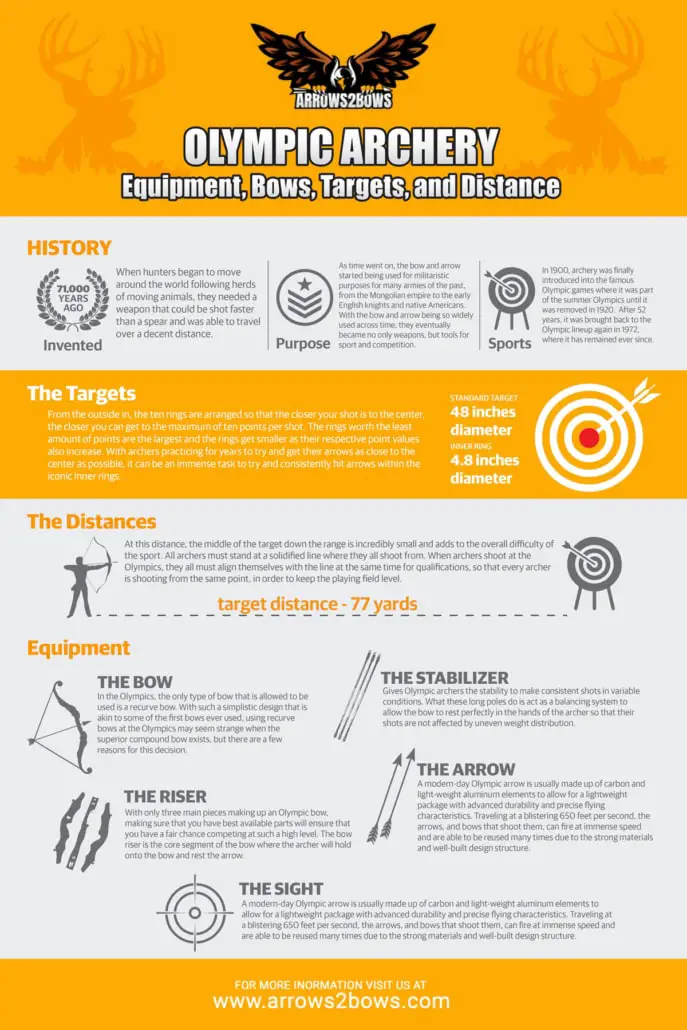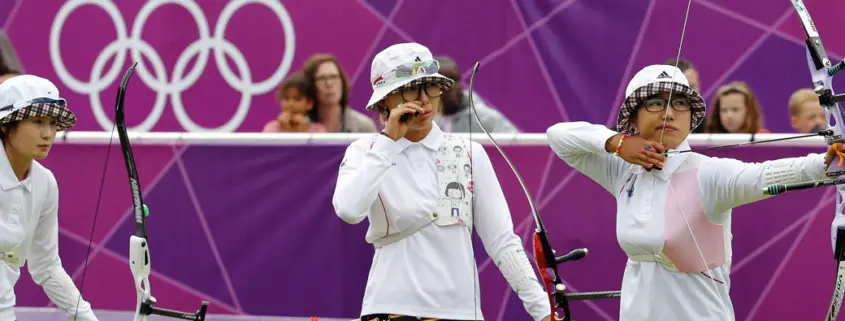Olympic Archery – Equipment, Bows, Targets, and Distance
Since the dawn of time, humans have been using bows and arrows to hunt animals so that they could ensure their own survival. The first bow and arrow may have been made from stick, bone, and string, but modern-day bow and arrows seem like a completely different beast altogether. They have been carefully crafted and designed to provide accurate and consistent shots for their users. For hunting, archers have benefited from the innovations in bow making by having bows that can shoot faster and hit harder, ensuring that they are killing animals in the most humane and efficient manner possible. However, today we will take a look at the world of Olympic archery, where athletes shoot at targets, rather than hunters at animals. How did Olympic archery come to be? What equipment helps make archers so accurate? We’ll answer this and some other common questions and misconceptions people have about Olympic archery.
History
As mentioned earlier, the earliest bow and arrow is believed to have been invented around 71,000 years ago! When hunters began to move around the world following herds of moving animals, they needed a weapon that could be shot faster than a spear and was able to travel over a decent distance.
As time went on, the bow and arrow started being used for militaristic purposes for many armies of the past, from the Mongolian empire to the early English knights and native Americans. With the bow and arrow being so widely used across time, they eventually became no only weapons, but tools for sport and competition.
As early as the 1840s, archery was losing its place in the world with the invention of the superior guns and crossbows. However, people still wanted to compete with bows and arrows, so many independent sporting leagues were created to enjoy archery as a sport.
In 1900, archery was finally introduced into the famous Olympic games where it was part of the summer Olympics until it was removed in 1920. After 52 years, it was brought back to the Olympic lineup again in 1972, where it has remained ever since. Archers from all around the world will gather in Tokyo in 2020 to test their skills and equipment to see which men and women will have the steadiest aim and the best shot for a chance to be immortalized among the great archers of history.
The Targets
Iconic around the world, the famous colored targets seen at competitive archery events leave even the spectators wondering what it takes to hit a bullseye with the whole world watching. The standard target archers use is roughly 48 inches in diameter with the innermost ring worth ten points being only 4.8 inches in diameter. From the outside in, the ten rings are arranged so that the closer your shot is to the center, the closer you can get to the maximum of ten points per shot. The rings worth the least amount of points are the largest and the rings get smaller as their respective point values also increase. With archers practicing for years to try and get their arrows as close to the center as possible, it can be an immense task to try and consistently hit arrows within the iconic inner rings.
The Distances
With the targets being naturally difficult to hit, having a distance that creates a sense of competition makes for an event that provides difficult to even the most experienced archers. Historically, the archers have shot at the target at a distance of 77 yards. At this distance, the middle of the target down the range is incredibly small and adds to the overall difficulty of the sport. All archers must stand at a solidified line where they all shoot from. When archers shoot at the Olympics, they all must align themselves with the line at the same time for qualifications, so that every archer is shooting from the same point, in order to keep the playing field level.
Equipment
From hunting in a forest to the final shot taken at the Olympics, every archer must balance their skills with their selection of equipment, whose purpose is to improve their overall performance. The Olympics have strict regulations in place that determine what assistive aids can be used, unlike when you hunt recreationally. Find the most essential pieces of equipment used by Olympic archers in order to help improve their accuracy below:
The Bow
Unquestionably the most important piece of equipment for any archer in any scenario – the bow. The bow an archer uses is essentially an extension of the archer, as they seek to learn how their bows work and how to extract the most performance out of them.
In the Olympics, the only type of bow that is allowed to be used is a recurve bow. With such a simplistic design that is akin to some of the first bows ever used, using recurve bows at the Olympics may seem strange when the superior compound bow exists, but there are a few reasons for this decision. While the skill of the archer is certainly important, the bows that are used can often completely change the outcome of a competition. If compound bows were introduced to the Olympics, it would no longer be a question of who has the most skill, but who has the best bow. The skill levels from different countries can range from historically dominant to brand new teams, so by keeping the playing field even, the Olympics are able to create an event that depends on the skill of the archer and not the superiority of the bow used.
In America and Europe, compound bows have become incredibly popular among hunting and sporting archers alike. This advantage over Asian countries who use the recurve bow in most archery activity would create vast differences among archers and put the teams with inferior bows in last place. Olympic recurve bows consist of a central riser and two limbs, which are attached by the firing string. Even though the design of these bows may seem very simple, the engineering and materials that created them is similar to the manufacturing process of a Formula One car. With teams chasing to implement new materials like carbon fiber and titanium into their bows, it is the small differences in the bows and accessories that can change the characteristics of how they shoot and give one archer an advantage over another.
The Riser
With only three main pieces making up an Olympic bow, making sure that you have best available parts will ensure that you have a fair chance competing at such a high level. The bow riser is the core segment of the bow where the archer will hold onto the bow and rest the arrow. With such a niche market, the most common and highly regarded distributor of Olympic risers and limbs is Hoyt Archery, who have been providing risers to the top names in archery for years. The benefit to having interchangeable risers and limbs means that an archer can mix and match parts to get the desired shooting characteristics that provide them with the highest accuracy possible. Allowing for adjustable arrow rest positions, string tension adjustment, and many other minute adjustments, modern risers are technological marvels compared to the traditional wooden bows of old. With the addition of carbon fiber and titanium builds, bows have become lighter and stronger than ever before.
The Stabilizer
When you look at a traditional bow and arrow compared to the advanced bow used at the Olympic level, the primary thing that literally and figuratively sticks out is those strange metal poles that branch out in several directions. Those poles are known as stabilizers and give Olympic archers the stability to make consistent shots in variable conditions. What these long poles do is act as a balancing system to allow the bow to rest perfectly in the hands of the archer so that their shots are not affected by uneven weight distribution. Archers can add or take away weights from these rods that allow them to change where the weight lies on the bow for varied shooting characteristics. An added befit of having the extra weight and stabilization in shooting is that the stabilizers also have the added benefit of absorbing the vibrations created during firing to reduce fatigue on the archer and allow for more accurate and consistent shots.
The Arrow
Even if an archer has the best bow in the world, they need to have arrows that are able to work with and add to the performance of their bows, to ensure a balanced platform. A modern-day Olympic arrow is usually made up of carbon and light-weight aluminum elements to allow for a lightweight package with advanced durability and precise flying characteristics. Traveling at a blistering 650 feet per second, the arrows, and bows that shoot them, can fire at immense speed and are able to be reused many times due to the strong materials and well-built design structure. The arrows are made up of the tip, the metal point that hits the target; the shaft, the long carbon-made element; and the knock, which locks into the firing string and holds the arrow to the bow.
The Sight
With such strict regulations with every other aspect of the bow, the sight that the archers use is no exception to the rules. Sights that improve the distance an archer can see have been banned for Olympic use, due to the unfair advantage they give to the user, who is able to see the targets easier than those without zoomed optics. Under Olympic regulations, archers may utilize pin sights that are basic, yet effective. The sights used by Olympic archers contain a few horizontal pegs, which are used to aim at different distances. This allows archers to adjust their aim and sight position, depending on varying weather conditions. Compared to the complicated hunting sights with levels and zooms, the basic sights used by Olympic archers are incredibly simple, but still allow for the archers to hit targets with extreme precision.

Frequently Asked Questions about Olympic Archery
With so many interesting facets to the sport of archery at the Olympic level, there are many questions that spectators may have. By answering some of the most frequently asked questions that are asked about the Olympic sport of archery, you will have a better understanding of everything that goes into archery and what makes it such an interesting sport.
What Kind of Bows do Olympic Archers Use?
When you see the Olympics on TV, you most likely will see the archers with very complicated bows and fancy arrows that look very complex. The interesting thing about the bows they use is that, while they may appear to be incredibly complicated, they are actually one of the simplest forms of modern bows. The bows Olympic archers use are called recurve bows and are essentially just modernized versions of a traditional wooden bow. Unlike compound bows with fly wheels and strong hitting power for hunting, recurve bows are designed for simplicity that provides accuracy. The reason for the bows looking so strange is the various mechanisms the archers have attached to their bows, like stabilizers and sights, which make the bows seem much more complicated than they actually are.
Is Archery an Olympic Sport?
While the verdict on archery as an Olympic sport has been debated for many years, most current day people would consider archery to be an Olympic sport. Archery as a sport in general is one of the oldest sports around the world. It has a rich history with various clubs and teams from all over the world coming up with their own competitions to see who among them was the best archer, either on foot or sometimes even on a horse. Added to the Olympics in 1900, archery remained popular in the early part of the century, but then disappeared for about fifty years as it was removed from the games. Archery made its comeback to the Olympics in 1972 and has remained to this day. With archery having a place at the next Olympic games taking place in Tokyo, the popularity of the sport has remained high and it has solidified its place among the Olympic community, where it appears it will remain for the foreseeable future.
What Size are Olympic Archery Targets?
The standard Olympic archery target size is about 48 inches in diameter or 1.22 meters. This target contains ten rings that vary in color and point value from the outside to the inside. The outside white rings give the archer either one or two points, the next black rings on the inside give three and four points, the blue rings next inside give five and six points, the inner red ring give seven and eight points, and the inner most yellow rings give nine and ten points. For Olympic archers, the goal of every shot is to hit somewhere in the yellow so they can get either nine or ten points per arrow. At a distance of 70 meters away, hitting the yellow target is incredibly difficult and requires a great amount of skill from any archer.
Do Olympic Archers Use Compound Bows?
While the bows Olympic archers use may look very similar to the complex compound bows, no competitor uses a compound bow for a few reasons. The primary reason that compound bows are not allowed to be used at the Olympics is that the complex wheel systems that are used by compound bows to provide stopping power and speed for hunting are just unnecessary for the Olympics, where the primary test is about who is most accurate. Another reason is that, while compound bows may be popular in America and Europe, the nations in Asia and Australia are more adapted to traditional recurve bows. By using recurve bows as the standard for the Olympics, the edge that would be gained for American and European teams with more powerful bows disappears, as every archer is forced to use the same general style of bow.
What Weight Bow do Olympic Archers Use?
Unlike bows used for hunting and other types of archery, Olympic bows are built to be as light as possible, while still providing enough power to send arrows flying at a high speed. While the weight of the actual bows can vary drastically, depending on an archer’s desired preference, most standard bows weigh on average somewhere around three pounds, naked. They are then made heavier with weights and balances to an archer’s preference. However, in archery terms, the more important weight that matters is the bows draw weight. This is the amount of force required to pull back a bow and how much energy the arrow fired will contain. An Olympic bow has an average draw weight of around 50 pounds, which is similar to some of the lower power compound hunting bows. The lower draw weight is a result of archers preferencing speed and consistency over power when it comes to precision archery.
Do Olympic Archers use Releases?
A release in archery is a small device that you can use to fire off shots consistently and is able to remove the strain on your fingers from holding a pulled back bow, as it displaces the pressure throughout your hand for more comfort. These devices are currently illegal in the Olympic archery world, due to the fact that they make firing an arrow an incredibly easy process and would result in a complete advantage to anyone using them. When hunters use these incredibly useful arrow releases, they act like a trigger, allowing them to fire their bows with a simple button push. While Olympians can’t use releases, they are allowed to use a tab to cover their fingers, so they are protected from the often-abrasive strings that they will be firing many times a session.
Why do Olympic Archers Swing Their Bows?
While it may appear at first glance like Olympic archer swing their bows just to make an affect, there is an actual reason for swinging the bow before shooting it. While it may seem like an archer has a firm grip on their bow from a distance, the grip an archer has on their bow is actually incredibly light as to prevent any tension on the bow that may lead to a missed target. The archers at the Olympics will tie their bow to the hand that is holding it lightly so that once the shot is fired, the tension that holds the bow up disappears and causes the bow to drop down, due to its added weight from stabilizers. The use of a string ensures the bow just swings down onto the archer’s hand and does not simply fall on the ground and break.
How far do Olympic Archers Shoot?
When Olympic archers shoot at the official games, they must shoot at a target at a distance of roughly 70 meters. However, many archers will actually practice their shooting from further away so that when they have to shoot regulation distances, it feels easier compared to the longer distance shots.
What is the Olympic Archery Distance?
In order to make sure there is a level playing field for competition, all archers at the Olympics shoot at targets from the same distance as one another. The current distance that archers shoot at the targets from is roughly 70 meters which is established by a line that all archers must stand behind. If an archer goes in front of this line or stands too far behind, they may be disqualified.
Enjoy the games!
With Olympic archery having such a rich history and so many regulations, it leads to be a complex and interesting sport. By understanding the equipment archers use, the heavily researched bows, and what makes the shooting special, understanding Olympic archery and enjoying the sport can be easier than ever before.

